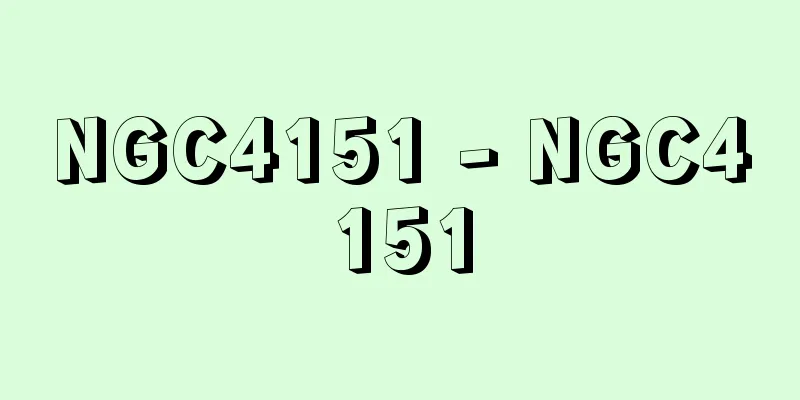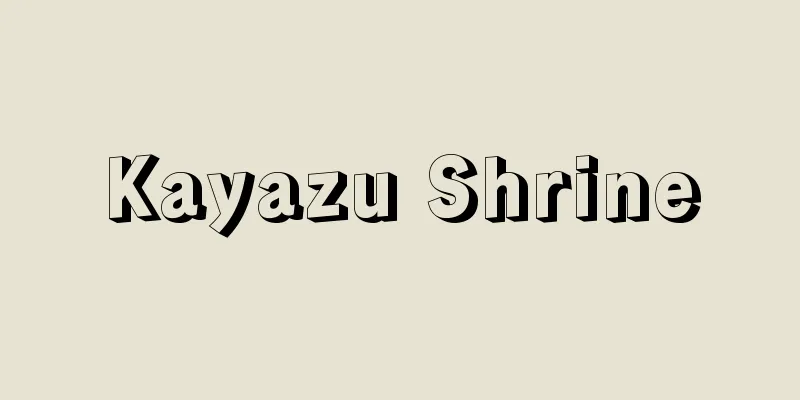Kasuri - Kasuri

|
It can also be written as Kajuri, Tobishira, or Kasuri, but nowadays it is common to write "Kasuri." There are two theories about the origin of the word Kasuri: one is that it was named after the faded look of the pattern, and the other is that it is the origin of the word Kasuri, which is called Ryukyu Kasuri, but neither theory has been confirmed yet. The Indonesian word ikat is used for the Romanization. In terms of technique, it is a type of pattern dyeing using the resist dyeing technique, where the yarn is partially dyed before it is woven and the pattern is then revealed. Kasuri is said to have originated in India, but since there are few remains from ancient times, it is difficult to say for sure. However, among the Ajanta murals in India, the ceiling murals from around the 7th century show clothing patterns that resemble ikat, and in Japan, the vertical ikat known as Taishikando (also called Canton Nishiki) is found on the textiles of Horyuji Temple, proving that ikat has been used since ancient times. It is unclear whether this technique was spread from India to various parts of the world or developed independently, but it has produced distinctive ikat patterns in various parts of the world, including Egypt, Persia, Indonesia, Mexico, and Peru. Ikat (ikat) from Southeast Asia is particularly well known. In Japan, from the Middle Ages to the early modern period, large striped dyeing methods such as step dyeing, tatsuna dyeing, and noshime dyeing were adopted, and the technique moved in the direction of simplification, but from around the mid-early modern period, the kasuri technique developed along with cotton, which became popular among the common people. The route of propagation gradually moved north from the Ryukyu Islands in the south, and it was introduced to cotton-producing areas all over the country. In the course of this development, it was also incorporated into silk and linen systems, and what started out as simple crosses and hailstones gradually evolved into complex illustrated kasuri patterns. Its heyday was relatively recent, beginning in the Meiji period. Kasuri can be broadly divided into those that are resist dyed and those that are printed. In addition, depending on the dyeing method of the constituent threads, they can be divided into warp ikat, weft ikat (weft-overall ikat), and warp ikat. The method of making ikat threads varies depending on the pattern to be expressed and the production conditions in each region, but there are several methods: "hand binding", in which the parts that have been pre-inked are tied with hemp or cotton threads (including synthetic threads), "orishime", in which a tightening machine is used to tightly weave only the parts of the weft threads that are resist dyed, and "itajime", in which the ikat threads are placed between two boards with a pattern carved into them to resist dyeing. Also, although kasuri does not fall under the rule of using resist dyeing techniques, there is a method in which the warp or weft threads are stencil-dyed on the surface of a fabric that has been temporarily woven, and then woven. Of these, those that are printed on the warp threads are called "hogushiori." In the same way, after the ikat is applied, the dye is rubbed in with a brush, or sometimes with a simple ikat application tool, and this is called "surikomi ikat." Recent dyeing techniques make it possible to directly print ikat patterns on woven fabrics, even creating something that looks exactly like ikat, so this may be an additional technique. Kasuri patterns are limited by dyeing techniques, and the outlines of the patterns are blurred, known as ikat-ashi, giving them a unique elegance. Patterns are created by weaving warp, weft, and warp ikat threads, so there are many types, from simple arare-like patterns to crosses, igata (lattice patterns), tortoiseshell patterns, arrow patterns, and patterned ikat (picture ikat). Complex ikat patterns that are difficult to match, such as warp ikat, can also be seen in Gringsing, Bali, Indonesia, but are also made in many parts of Japan. Many of the ikat patterns seen around the world are warp ikat, like ikat, and express designs that are unique to the ethnic characteristics of each region. The main producers of kasuri today are India, Indonesia and Guatemala, and the tradition has not been lost. Kasuri production in Japan started in cotton producing areas and expanded to silk, linen and silk-cotton mixed weaves. Cotton kasuri includes Kurume kasuri, Iyo kasuri, Bingo kasuri, silk kasuri, Ryukyu kasuri, Yuki tsumugi, Oshima tsumugi, and linen kasuri includes Echigo jofu (Ojiya chijimi) and Noto jofu. In terms of its uses, it was popular as clothing for the common people, and was widely used for kimono fabric from the Meiji to Taisho periods, but in recent years, indigo kasuri has been limited to farmer's work clothes, and complex kasuri patterns are used for luxury items, and its uses have diversified. However, kasuri is still used for everyday wear and cannot be used for formal kimonos. [Kadoyama Yukihiro] “Alfred Bühler Ikat, Batik, Plang (1972, Phavous-Verlag Hansrudolf Schwabe AG, Basel)” ▽ “Ekasuri” by Hideo Oda (1977, Iwasaki Bijutsusha)” ©Shogakukan "> Warp ikat ©Shogakukan "> Weft ikat ©Shogakukan "> Warp and weft ikat Nationally designated important intangible cultural property Kurume City, Fukuoka Prefecture © Fukuoka Prefecture Tourism Federation Kurume Kasuri Fukuyama City, Hiroshima Prefecture © Fukuyama Tourism and Convention Association Bingo Kasuri Yonago City, Tottori Prefecture ©Tottori Prefecture "> Yumigahama Kasuri Nationally designated important intangible cultural property Kurume City, Fukuoka Prefecture ©Shogakukan "> Kurume Kasuri (woven pattern) Important Intangible Cultural Property Ojiya City, Niigata Prefecture ©Shogakukan "> Echigo Jofu (woven pattern) Yonago City, Tottori Prefecture ©Shogakukan "> Yumigahama Kasuri (woven pattern) Source: Shogakukan Encyclopedia Nipponica About Encyclopedia Nipponica Information | Legend |
|
加寿利、飛白、纃などの字に書くこともあるが、現在では「絣」をあてるのが普通である。この絣とは、模様がかすったようになることからつけられたという説と、琉球(りゅうきゅう)絣をカシィリィということから、これが語源であるとする説とがあるが、まだいずれとも確言しうるに至っていない。欧文表記としてはインドネシア語のイカットikatをそのままあてている。技法からみると、防染技法による模様染めの一つであり、糸の段階で部分的に染色したのち織り上げ、その後模様を表すものである。 絣の起源は、インドの所産といわれているが、古い時代の遺品が少ないため、なんとも確言しがたい。ただインドのアジャンタ壁画のうち、7世紀ごろの天井壁画のなかに、着衣の模様に絣らしいものがみられること、日本でも法隆寺裂(ぎれ)に、太子間道(たいしかんどう)(広東錦(カントンにしき)ともいう)といわれる経(たて)絣があって、古くから絣が使われていたことを物語っている。この技法がインドから各地へ伝播(でんぱ)したものか、独立的に発生したかは不明であるが、エジプト、ペルシア、インドネシア、メキシコ、ペルーなど世界各地に特色のある絣を生んだ。とくに東南アジアのイカット(絣)はよく知られている。日本では、中世から近世にかけて、段染め、手綱(たづな)染め、熨斗目(のしめ)という大きくだんだらに染める方法がとられ、単純化の方向へと進んだが、近世中期ごろから庶民の間に普及した木綿とともに絣技法が展開していった。その伝播経路は、南方の琉球からしだいに北上していき、それが各地の木綿生産地に伝わった。この展開過程において、絹・麻系統へも摂取されたし、初め簡単な十字、霰(あられ)などの模様であったものが、しだいに複雑な絵絣まで織り出すこととなった。その最盛期は比較的新しく、明治時代に入ってからである。 絣は大別して、防染によるものと捺染(なっせん)によるものとに分けられる。また構成糸の染色方法により、経(たて)絣、緯(よこ)絣(緯総(よこそう)絣)、経緯絣に分けられる。絣糸をつくる方法は、表出される図柄の違いや、各地の生産事情により異なるが、麻糸・綿糸(合繊糸をも含む)などで、まえもって絣つけした部分をくくる「手くびり」、締(しめ)機を使い、織物の緯糸を防染する部分だけ堅く織りつける「織締(おりしめ)」、文様を彫り込んだ2枚の板の間に絣糸を入れて防染する「板締(いたじめ)」がある。また、絣は防染技法を伴っているという原則からは外れるが、経糸あるいは緯糸を仮織りした布面に型染めし、それを織る方法がある。そのうち経糸に捺染したものは「解織(ほぐしおり)」という。同じように絣つけをしたのち、刷毛(はけ)、ブラシ、ときには簡単な絣つけ道具で染料を摺(す)り込み絣をつけるものを「摺り込み絣」という。最近の染色技術は、織物の上に絣柄をそのまま捺染でき、外観上なんら絣と変わらないものまでつくりだせるので、追加される技法かもしれない。 絣の文様は、染色技法に制約を受けて輪郭部分は、いわゆる絣あしというぼやけたものとなり、独特の雅味を呈するのが特徴である。経あるいは緯、そして経緯の絣糸を製織により文様構成させるので、単純な霰のようなものから、十字、井桁(いげた)、亀甲(きっこう)、矢柄、模様絣(絵絣)など種類が多い。経緯絣のように柄合わせのむずかしい複雑な絣は、インドネシア、バリ島のグリンシンにもみられるが、日本の各地に多くつくられた。世界各地にみられるものは、イカットのように経絣のものが多く、その地域独自の民族的特徴をもつ図柄を表現している。 現代における絣の主要な生産地はインド、インドネシア、グアテマラで、その伝統は失われていない。日本の絣の生産は、木綿の生産地におこり、絹、麻、絹綿交織へと展開した。したがって綿では久留米絣(くるめがすり)、伊予絣、備後絣(びんごかすり)など、絹では琉球絣、結城紬(ゆうきつむぎ)、大島紬などがあり、また麻では越後上布(えちごじょうふ)(小千谷縮(おぢやちぢみ))、能登(のと)上布などにみられる。 用途は、発展理由からみて庶民の衣料として普及し、明治から大正にかけて着尺地に盛んに使われたが、最近では紺絣は農家の仕事着に限定され、複雑な絣柄は高級品に使われ、用途も分化している。しかし絣はあくまでも普段着であり、正式の着物とはなりえない。 [角山幸洋] 『Alfred BühlerIkat, Batik, Plang (1972, Phavous-Verlag Hansrudolf Schwabe AG, Basel)』▽『織田秀雄著『絵絣』(1977・岩崎美術社)』 ©Shogakukan"> 経絣 ©Shogakukan"> 緯絣 ©Shogakukan"> 経緯絣 国指定重要無形文化財 福岡県久留米市©公益社団法人福岡県観光連盟"> 久留米絣 広島県福山市©公益社団法人福山観光コンベンション協会"> 備後絣 鳥取県米子市©鳥取県"> 弓ヶ浜絣 国指定重要無形文化財 福岡県久留米市©Shogakukan"> 久留米絣(織紋) 重要無形文化財 新潟県小千谷市©Shogakukan"> 越後上布(織紋) 鳥取県米子市©Shogakukan"> 弓ヶ浜絣(織紋) 出典 小学館 日本大百科全書(ニッポニカ)日本大百科全書(ニッポニカ)について 情報 | 凡例 |
<<: Guthrie, Sir William Tyrone
Recommend
Pharaoh's ant (English spelling) Pharaohsant
...They build nests in stalks of dead grass or ro...
Prunus pauciflora (English spelling)
… [Isao Shimura]. … *Some of the terminology that...
Alkaline addition method - Alkaline addition method
…Also, to make up for the sake shortage during Wo...
Pecan - Pecan (English spelling)
A deciduous tall tree of the genus Caria in the J...
International Convention on the Elimination of All Forms of Racial Discrimination
Its official name is the International Convention...
"Eawase Taikouki" - Eawase Taikouki
...13 sections. Also called Ego Taikoki. A collab...
Old Norse
The Norse language, which is the origin of the Nor...
No. 1 Ship Bottom Paint - Ichigo Ship Bottom Paint
...paint used on steel ships to prevent corrosion...
National Gallery, London
The National Picture Gallery in London. Its origin...
Ismir - Ismir
…It is widely distributed from central Honshu sou...
Threshold - Threshold
A horizontal bar laid on the floor when dividing ...
Winfried
[Birth] 680 yen [Death] 755 A clergyman and missio...
Oomukashibushi - Oomukashibushi
...Including Kumiodori and Hashiodori, court danc...
Chicken
Chickens were domesticated about 6,000 years ago ...
Hijudai
This plateau occupies the southeastern part of th...









